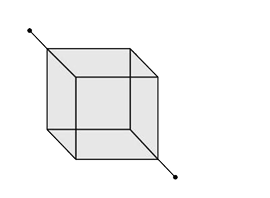When a resistance wire is passed through a die the cross-section area decreases by 1%, the change in resistance of the wire is
1% decreases
1% increases
2% decreases
2% increases
The correct Answer is:D
To solve the problem, we need to understand how the resistance of a wire changes when its cross-sectional area is altered while keeping the volume constant. Let's go through the solution step by step.
1. Understanding the Volume Conservation:
When a resistance wire is drawn through a die, its volume remains constant. The volume V of the wire can be expressed as:
V=A×L
where A is the cross-sectional area and L is the length of the wire.
2. Expressing Changes in Area and Length:
Since the volume is constant, if the cross-sectional area decreases, the length must increase to keep the volume the same. This relationship can be expressed as:
A1×L1=A2×L2
where A1 and L1 are the initial area and length, and A2 and L2 are the new area and length.
3. Percentage Change in Area and Length:
Given that the area decreases by 1%, we can express this as:
ΔAA=−0.01
From the conservation of volume, we can relate the change in area to the change in length:
ΔAA=−ΔLL
Thus, if the area decreases by 1%, the length must increase by 1%:
ΔLL=0.01
4. Resistance Formula:
The resistance R of the wire is given by:
R=ρLA
where ρ is the resistivity of the material.
5. Calculating Change in Resistance:
To find the change in resistance, we can express the relative change in resistance as:
ΔRR=Δρρ+ΔLL−ΔAA
Since the resistivity ρ remains constant, Δρρ=0. Therefore, we have:
ΔRR=ΔLL−ΔAA
6. Substituting Values:
Substituting the values we found:
ΔRR=0.01−(−0.01)=0.01+0.01=0.02
This means the change in resistance is:
ΔR=0.02R
Thus, the percentage change in resistance is:
ΔR (in percentage)=0.02×100=2%
7. Conclusion:
Since the change is positive, the resistance increases by 2%. Therefore, the final answer is:
The change in resistance is +2%.
When a resistance wire is drawn through a die, its volume remains constant. The volume V of the wire can be expressed as:
V=A×L
where A is the cross-sectional area and L is the length of the wire.
Since the volume is constant, if the cross-sectional area decreases, the length must increase to keep the volume the same. This relationship can be expressed as:
A1×L1=A2×L2
where A1 and L1 are the initial area and length, and A2 and L2 are the new area and length.
Given that the area decreases by 1%, we can express this as:
ΔAA=−0.01
From the conservation of volume, we can relate the change in area to the change in length:
ΔAA=−ΔLL
Thus, if the area decreases by 1%, the length must increase by 1%:
ΔLL=0.01
The resistance R of the wire is given by:
R=ρLA
where ρ is the resistivity of the material.
To find the change in resistance, we can express the relative change in resistance as:
ΔRR=Δρρ+ΔLL−ΔAA
Since the resistivity ρ remains constant, Δρρ=0. Therefore, we have:
ΔRR=ΔLL−ΔAA
Substituting the values we found:
ΔRR=0.01−(−0.01)=0.01+0.01=0.02
This means the change in resistance is:
ΔR=0.02R
Thus, the percentage change in resistance is:
ΔR (in percentage)=0.02×100=2%
Since the change is positive, the resistance increases by 2%. Therefore, the final answer is:
The change in resistance is +2%.
Topper's Solved these Questions
Similar Questions
The length of a given cylindrical wire is increased by 100%. Due to the consequent decrease in diameter the change in the resistance of the wire will be
View SolutionThe resistivity of a wire
View SolutionWhen the length and area of cross-section both are doubled, then its resistance
View SolutionState whether the resistivity of a wire changes with the change in the thickness of the wire.
View SolutionTwo wire of the same meta have same length, but their cross-sections are in the rati 3:1 . They are joined in series. The resistance of thicker wire is 10Ω . The total resistance of the combination will be
View SolutionThe Poisson's ratio of a material is 0.5. If a force is applied to a wire of this material, there is a decrease in the cross-sectional area by 4%. The percentage increase in the length is
View SolutionThe wire is stretched to increase the length by 1%. Find the percentage change in the resistance.
View SolutionTwelve wires of equal length and same cross-section are connected in the form of a cube. If the resistance of each of the wires is R, and the effective resistance between the two diagonal ends is Re, then the ratio RRe is equal to __.

View SolutionA wire of resistance 4Ω is stretched to twice its original length. In the process of stretching, its area of cross-section gets halved. Now, the resistance of the wire is
View SolutionWhen the length of a wire is increased by 5%, its radius decreases by 1%. The Poission's ratio for the material of the wire is
View Solution
